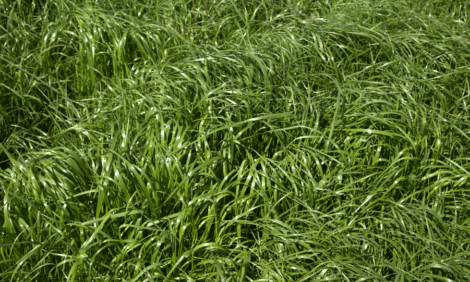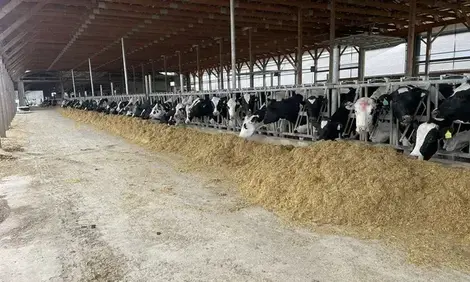



Continued Strength for Cattle Prices in 2012
2012 will be another year of record high cattle and beef prices with diverging impacts for various segments of the industry. Again, Brazil is the only country expected to increase beef production, reports Rabobank in their Beef Quarterly.Global Overview
Rabobank expects to see continued strength in cattle markets in 2012, with the potential for double digit gains again this year. There are limited downside price risks for Q1 2012 as Rabobank expects a slightly larger global supply amidst a backdrop of slowing winter demand in the Northern Hemisphere. However, for the rest of the year cattle prices should post record highs as markets transition from the short term supply bulge (primarily US and Brazil) to materially lower supplies. For the longer term. our view is that global meat protein supplies will continue to lag income and population growth in important emerging markets, raising volume risks to processors and price risks to everyone from feeder cattle buyers to consumers.
Rabobank Global Cattle Price Index remained strong in Q4 as supply conditions continued to be relatively tight throughout the world. The index is slightly off of its high, influenced by US dollar appreciation (see Figure 1) in the period, but even so, the index closed the year 10% higher than the level at which it began 2011 (see Figure 2).
Rabobank Beef Forex Index reached the highest level of the year as a combination of a reduction in investor exposure to the Euro—induced by risk aversion—and signs of improvement in the American economy led to US dollar strength. Additionally, given the difficulties in the European financial market, banks and companies were forced to look for funding primarily in US dollars. Even so, in a year-on-year comparison, the index fell 5% below the average seen in 2010.
Industry consolidation continued in Q4 2011 around the world. Recent takeovers in Europe were motivated by a desire for supply security. With this in mind, Tönnies acquired the assets of the insolvent Allgäu Fleisch in southern Germany. Irish Dawn Meats acquired Duerden Lindal Moor Beef Abattoir in Ulverston, Cumbria, UK. Irish food group Anglo Beef Processors bought RWM Food Group.
In the US, Leucadia National Corporation agreed to acquire 79% of National Beef Packing (NBP) for USD 867.9 million plus the assumption of USD 360 million in long-term debt. The enterprise value to trailing EBITDA ratio of 4.2 is in line with current trading ratios for other major publicly traded meat processing companies. Prior to the deal, NBP was majority-owned by US Premium Beef (USPB), a producer-owned marketing company. The deal was likely motivated by a desire for liquidity among USPB’s diverse ownership base.
Rabobank Beef Forex Index Against the US Dollar
Jan 2006 =100
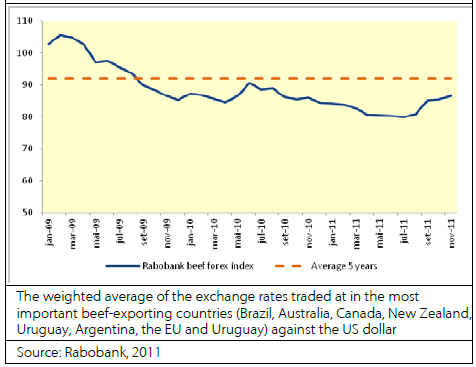
Borrowing costs are on the rise as uncertainties involving Europe’s debt crisis have pushed bank funding costs up and triggered investor risk aversion. The recent increase in average bond yields per sector is shown in Figure 3.
Russia is set to join the World Trade Organization (WTO) but there are no signs that the current obstacles for beef imports will be removed in the short term. The quota system that regulates imports through the imposition of high tariffs beyond a determined volume is set to continue shaping the trade relationship with Russia.
South Korea ratified a Free Trade Agreement with the United States (US) in November 2011. The Agreement is set to take effect as early as January 2012 and aims to gradually reduce tariffs on American beef from 40% to zero within 15 years. The Agreement is clearly good news for the US, but it is a cause for concern in Australia. Korea is Australia’s third largest export market after Japan and the US.
Rabobank 7-Nation Finished Cattle Price Index
Jan 2006 =100
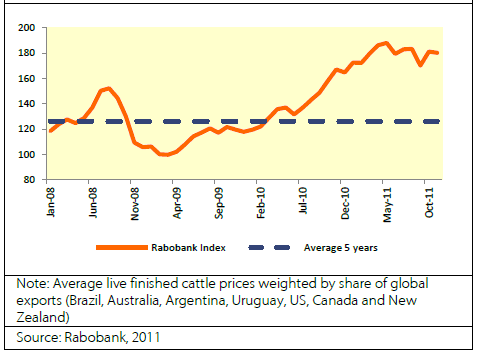
Regional Updates
Brazil
After peaking in mid-November as a result of reduction in feedlot marketings coupled with the dry period, cattle prices lost ground in December 2011. The reason for this decrease in prices was the reduction in wholesale values due to the slowdown in domestic demand. Even so, the average price throughout Q4 was 1% higher than the previous quarter.
Headwinds for cattle and wholesale beef prices also came from reduced beef exports, which remained low even with the depreciation of the Brazilian real in Q4. In the first two months of Q4, Brazil exported 193,000 tonnes, down 2% over the same period in 2010. Year-to-date exports are 14% below previous year’s levels.
For Q1 2012 Rabobank expects to see supply increasing seasonally (rainy season), which can be exacerbated by the higher calf crops in 2009 and 2010 . This increase in supply coupled with an anticipated deceleration in domestic consumption should push cattle prices down. However, a possible increase in beef exports reduces the likelihood of a more significant decrease in prices.
United States
Fed cattle and choice cut-outs achieved record high prices for the year in Q4 of USD 128/cwt and USD 1.96/lb, respectively. However, negative beef packing margins since the end of Q3 have pushed processors to cut back on slaughter. The six-week rolling average for slaughter fell from 653 thousand head at the beginning of Q4 to 608 thousand head for the week ending 31 December, which is 1.5% below year-ago levels. Packing margins have yet to respond positively. Reduced slaughter levels will have to be maintained to get packing margins back in the black.
The choice-select spread widened dramatically in Q4 2012 as the world’s largest retailer, Walmart, began stocking its meat case with choice beef.1 The spread, which averaged only USD 7 in Q3 spiked to almost USD 20 in Q4, a level not seen since 2006. The spread is likely to remain at historically wide levels with Walmart’s ongoing demand.
US beef exports remained strong in Q4 2012. Year-to-date export volume is up 25% over 2010 levels, led by exports to Canada and Mexico. A still relatively weak US dollar relative to other major exporters also helped drive strong exports to Japan and South Korea. Rabobank expects export demand to continue on the back of a weak US dollar and progress in trade barrier reduction. The Korea-United States Free Trade Agreement calls for beef import tariffs to fall from 40% to zero over the next 15 years. A positive outcome in the US beef industry’s campaign to raise Japan’s age limit on imported beef from 20 months to 30 months could further support exports in 2012.
USDA’s December Cattle on Feed report showed that continued drought induced placements of light cattle. Overall inventory of cattle on feedlots was up 3.6% over year-ago levels and placements onto feedlots were 4.0% over year-ago levels. However, the higher placements were driven almost entirely by light cattle that would typically spend more time on pasture prior to being placed in a feedlot. Placements of light cattle—those weighing less than 600 pounds—were up 20.8% over year-ago levels while total placements of all other heavier weight categories was down 3.7%. These light cattle are less likely to grade choice than heavy cattle, supporting the choiceselect spread well into 2012.
Rabobank expects softer cattle prices in Q1 2012 as typically lower winter demand coincides with last summer’s high placements becoming market ready, causing fed cattle supply to outstrip demand. However, scarcity in the fed cattle markets will begin make itself felt in Q2 2012, likely resulting in record high prices as we move through the remainder of the year.
Credit Suisse Emerging Market Bond Yields Per Sector
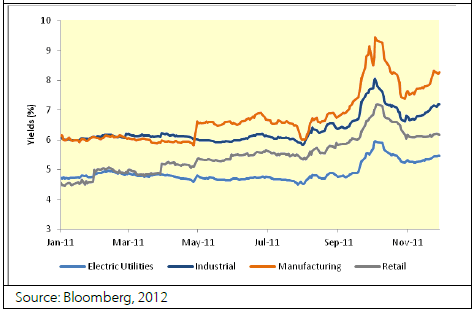
EU
EU beef prices continued their contracyclical development with a further price rise to levels above EUR 3.75 per kg in the last months of 2011. The unexpected upswing of EU beef exports to Turkey, after the gradual decline since mid- 2011, and the absence of the normal supply boost last autumn largely contributed to this development.
Beef exports to Turkey have increased unexpectedly since October 2011, driven by plummeting live exports from France, which totalled 60,000 head in September and 107,000 in October. Total EU exports from January-October reached 530,000 tonnes, an increase of 54% and already exceeding the 2010 total by almost 50,000 tonnes.
Despite record export levels, slaughter numbers in the EU increased only slightly (+0.4% Jan-Sep). Thus, cattle supplies for slaughter remain tight. When combined with a 17.3 percent decline in imports, this suggests relatively soft EU consumer demand relative to world markets.
Tight supplies will continue to support EU beef prices at an elevated level, but some downward pressure is to be expected in Q1 2012. The difficult economic situation will further impact EU beef demand. Additionally, the recovery in exports to Turkey is only temporary. Rabobank expects these exports to resume a declining trend in the near future.
Australia
Much of the activity in saleyards in late 2011 was motivated by fierce restocker activity and feeder demand for cattle, with the wet summer expected to continue to underpin solid pricing in Q1 2012. The slightly weaker AU dollar has also been an encouraging stimulus for cattle prices in the last quarter of 2011, with the Eastern Young Cattle indicator increasing to a December record of AUD 4.14/kg cwt, and bringing the index average for the quarter to AUD 4.03/kg cwt, representing a lift of 12% YOY with 2010.
Australian cattle slaughter for Q4 remained solid but remains down on Q3, which experienced a strong lift yearon- year. Q3 2011 saw a peak processing lift of 15% on the previous period. The start of 2012 (Q1–Q2) is likely to continue to see slaughter numbers soften, following seasonal trends and with competing demand for herd rebuilding, which should support prices through 2012.
However, a possible reduction in exports to Indonesia should put pressure on prices, notably in the Northern Territory. Indeed, there have been rumours that Indonesia intends to limit live imports to 283,000 head and 34,000 tonnes of boxed beef in 2012 in order to improve selfsufficiency over the next four years.
ABARES (Australian Bureau of Agricultural and Resources Economics and Sciences) is forecasting the Australian cattle herd to rise a further 5% to reach 30.2 million by mid-2012, the largest national herd in the last 40 years. In contrast though, it is also expected that slaughter will actually drop, as herd rebuilding continues strongly and slaughter drops to 7.9 million heads. Although total slaughter is set to decline, Rabobank expects that beef production will remain relatively stable as average carcass weight should be higher than in the previous year.
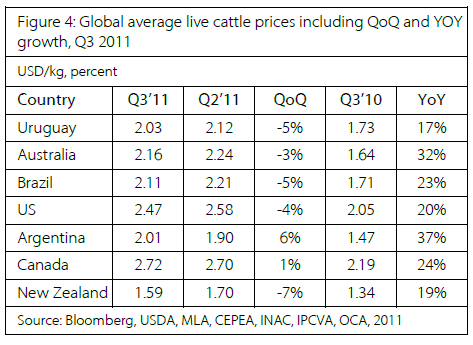
Argentina
The number of animals slaughtered in Argentina remained below that of 2010 during Q4 2011, still as a result of the herd rebuilding process. However, the year-on-year difference narrowed as the intensity of retention decreased, stimulated mainly by water shortage in some areas of the country. In October 2011 (when the last numbers were published) total slaughter was 2% lower YOY, while a YTD comparison showed a larger difference of 12%.
Beef consumption (per capita) in the first ten months of 2011 averaged 53.8 kg. This is 6.8% lower than in 2010 and 20% lower than what it was in 2009 (when consumption per capita reached peaks of 68.8 kg). Consumers have cut down their demand for beef and are substituting beef with cheaper meats such as chicken.
Currently, 90% of production is sold domestically. Exports (in quantity) decreased by 10% in the first ten months of 2011, but increased by 15% in value terms given higher international prices. As was the case in previous years, only 40% of the total Hilton quota had been allocated to exporters by the end of 2011, even though more than half of the 2011/12 period was over.
For Q1 2012, we expect demand to continue at similar low levels, given a possible slowdown in economic activity and the reduction in disposable incomes as a result of increased costs of electricity, among others. Supply is also set to remain low, still as a side effect of the cow retention.
On the industry side, the market leading hamburger brand Paty changed hands from Marfrig to BRF as a result of the Marfrig-BRF asset swap. This included the processing units of hamburgers, hams, sausages, vegetables and a slaughtering unit with depots and an extensive distribution structure. BRF had recently acquired Avex, a poultry company, and Danica, a margarine producer. As a result, BRF is becoming a strong player in the Argentine market.
New Zealand
Cattle prices lifted on average NZD 0.33c/kg cwt quarter-onquarter in Q4 2011, boosted by the lack of stock for processing during Q4 2011which was caused by higher than usual cow slaughter in the beginning of the year as a result of an early dry summer in 2010 (Dec 2010 – Feb 2011). Additionally, dairy farmers were encouraged to hold stock for production through the coming summer spurred by high feed availability and solid milk prices. Cow slaughter in Q4 2011 was 20% lower than in the same period of the previous year. Prices were also influenced by the strong lifts seen in Australia and in the US markets.
For 2012, Rabobank expects a small production lift, and this is likely to flow through in Q1 and Q2. Exports are likely to grow by 3%, boosted by a currency advantage over Australia, which may provide a comparative advantage for US beef importers in securing New Zealand product in Q1 and Q2.
China
While China’s beef supply remained tight in Q4 2011, demand accelerated, boosted by the high season for consumption, which resulted in higher wholesale prices.
Due to the rising cost of corn and other feed inputs, individual beef cattle farmers still have little incentive to build up stock. But large-sized cattle farms are moderately expanding production. The growth of up-scale farms is mainly driven by meat slaughterers/processors who are developing upstream integration to secure consistent supply.
Given the tight domestic supply and high prices, beef imports are believed to have increased to cover the supply shortage. However, direct beef imports decreased by 22% in the first ten months of 2011, on a year-on-year basis (15,764 tonnes). The reason for the import decline is believed to be a huge amount of illegal imports through grey channels. Illegal imports negatively impacted the direct imports as well as the recovery of domestic production. As this dynamic persists, Rabobank expects China’s government to open beef imports to more suppliers in the future.
Prices are expected to rise further in January 2012, due to the coming festival for Chinese Lunar New Year in late January, but will likely fall entering February, when the festival season ends.
Mexico
As a result of the ongoing drought in the north-eastern part of the country, government estimates place losses at 50,000 head of cattle. With limited carrying capacity, exports of feeder cattle through September 2011, the latest date for which data is available, reached 1.37 million head. This is more than all of Mexico’s 2010 live cattle exports (1.26 million head) and is also considerably higher than the 777,000 head of cattle exported during the same first nine months of 2010.
The increase in exports of feeder cattle, which Rabobank expects involved larger numbers of heifers, will hold back the expansion of the domestic herd. The contraction in the availability of feeder cattle has pushed up prices by as much as 10%, with prices to feeders expected to continue increasing through 2012.
Imports continued contracting in 2011. Fresh and frozen beef and offal imports through September were down 8.4 and 12.5% , respectively. Increases in average prices for imports of over 20% for fresh beef and 17% for offal go a long way in explaining the fall in imports.
At the consumer level beef prices increased 9.9% during the first eleven months of 2011, well ahead of poultry and pork prices as well the overall consumer price index. According to industry sources, the loss in relative competitiveness, as expressed in terms of prices, has resulted in a fall in beef consumption. Rabobank expects high prices for imported meat in 2012 to support prices on the domestic market.
Uruguay
Supply of beef in Uruguay has remained low relative to last year as a result of herd liquidation which continued into 2010 following drought. Year–to-November 2011, the number of animals slaughtered was estimated to be 7% lower than the same period in 2010.
Consequently, export volumes continued dropping, with sales declining 9% between January and October 2010 on a YOY basis despite the buoyant demand for Uruguayan beef. However, revenues in US dollars increased 21%, supported by strong international prices.
For Q1 2012, Rabobank expects Uruguayan beef production to remain below 2010 levels assuming relatively normal weather. This should result in favourable calf prices, which will incentivise producers to retain heifers. Consequently, exports are likely to remain constrained over the same period.
Japan
Japan’s economic activity has recovered relatively well from the damage caused by the earthquake and the tsunami in March 2011. After a contraction in the first half of 2011, positive economic growth returned in the second half of the year and the momentum associated with this rebound will directly bolster the economy through 2012.
However, beef consumption remains stagnant, and increased substitution of pork and chicken for beef has been noticed, despite aggressive promotion from retailers. Demand for premium meat and domestic Wagyu beef is especially weak. July 2011’s incident of radiated Japanese beef being found on the retail shelves is still in the back of consumers’ minds, thereby diverting demand towards imported product for food safety reasons.
Not surprisingly, beef imports continue to increase their share of domestic consumption, with the total volume of imports for January-October 2011 ( 420,000 tonnes) having lifted 5% YOY. The continued weak US dollar allowed US beef imports to be price competitive on a yen basis. As a result, US beef imports for January to early December increased 43% (YOY) reaching 127,000 tonnes. Imports of beef rose in part as a result of strong demand in the food service sector for frozen meat, which partially offset the decline in sales of premium fresh and chilled cuts.
Australian beef exports to Japan are forecast to fall by 4% to 336,000 tonnes in 2011-12. This forecast decline reflects the combined effect of expected stable beef consumption in Japan and increased competition from US beef in the Japanese market.
Japan may agree to a new bovine spongiform encephalopathy (BSE) risk protocol that is likely to see US beef age limits raised from animals less than 20 months to under 30 months. According to traders, the new regulation could be implemented at the beginning of Japan’s next financial year on 1 April. Such change would trigger stronger supply competition out of the US.
Rabobank expects Japanese beef demand to be steady to slightly weaker in 2012 due to overall economic uncertainty increasing consumer price sensitivity.
Industry comments
2012 will be another year of record high cattle and beef prices with diverging impacts for various segments of the industry. Ranchers will benefit from scarce cattle supplies while feedlots and packers face challenges.
Tight cattle supplies—as result of either weak rancher margins over the past years or weather-related problems—will push power up the value chain. Ranchers are set to enjoy some of their best margins in years. Conversely, feedlots and packers should be concerned about both higher prices and limited availability of inputs exacerbating low capacity utilisation problems and causing margin compression.
Beef processors’ ability to pass through pricing to consumers will be tested in 2012. Global economic growth has been inconsistent, with growth slowing in many markets. In the world’s largest consumer markets, Europe and the US, growth has been particularly slow. We have not identified it yet, but there is a limit to what consumers will pay for retail beef.
Additionally, the ongoing debt crisis in Europe presents a unique tail risk for some beef processors. If the banking system becomes stressed to the point at which it has to withhold credit, cashstrapped beef companies will struggle. In conjunction with margin compression, possible credit strains could set the stage for accelerated M&A activity in the beef industry. We began to see signs of this in Q4 2011, with several transactions announced in Europe and in the US.
Although the big picture remains challenging for certain segments of the industry, the outlook for beef companies does look positive for 2012 in some countries. Among them, Brazil stands out. Of the top producer countries, Brazil is the only one that is expected to show a combination of increased supply of animals for slaughter, robust domestic demand and a growth in exports (see Figure 5).
This more favourable scenario for companies operating in Brazil should be viewed as an opportunity for the sector to generate better results and deleverage balance sheets, thus mitigating possible credit-related risk.

January 2012

